1. ABSTRACT
Water is an essential ingredient in the tissue making process and its reduction is a very sensitive topic. It is necessary to find the right balance between water reduction advantages and disadvantages.
Water reduction leads to the closure of the process water circuit, which can affect the tissue making process. In this study, we will illustrate state-of-the-art solutions to substantially reduce water consumption ensuring an efficient paper production.
In this field, great progress has been made in recent years, but the increasing stress on fresh water availability and widespread calls to reduce water usage have put water reduction strategies at the forefront of technological development.
In this article, we analyse the best practices and most advanced available technologies to reach a freshwater consumption in the entire tissue making plant lower than 4 m3/ton paper.
This ambitious target can be reached by working on four main areas:
- Machine showers
- Suction roll sealing technologies
- Cooling utilities management
- Stock preparation
2. INTRODUCTION
Water use in the industrial sector at large is one of the most important topics of debate; in particular, in paper production this natural resource is an essential component for fibres transportation, equipment cleaning, lubrication, cooling and in the achievement of high tissue quality.
Due to growing economic and environmental pressures, water saving strategies are one of the most important driving forces for paper technology development. It is important to underline that pushing the tissue making process toward actual water reduction has significant negative impacts on several technological operations.
Water reduction approaches are very complex and bring to a progressive closure of the process water loop, which leads to accumulation of contaminants and may cause paper defects, deterioration of product quality and problems with tissue machine run-ability.
The degree of water loop closure is strictly correlated with the negative impact that may affect the paper process as shown by K. Olejnil et al [1] and J. Boguniewicz-Zabłocka et al [2]. In this context, it is crucial to establish the right equilibrium between advantages and disadvantages relevant to water consumption restrictions.
The water consumption of today’s paper making processes varies between 5 and 20 m3/ton paper [1].
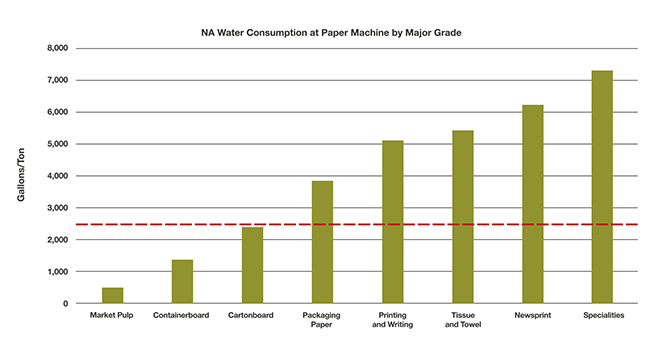 Fig. 1. Water consumption at paper machine by major grade. Data from Fisher International for 2020
Fig. 1. Water consumption at paper machine by major grade. Data from Fisher International for 2020
In particular, water consumption for tissue paper mills that work with virgin pulp is close to 5 m3/ton paper compared to mills that operate with recycled fibres.
There are two main approaches to water consumption, which can be combined to maximize water savings [3]:
- Implementation of advanced water treatment processes for wastewater recycling and re-use
- Development of new technologies that reduce water consumption.
The water re-use approach requires an advanced water treatment plant with specific purification technologies such as flotation, biological reactors, and membrane filtration, as described by M. Karthink et al [4].
Toscotec has taken up this technological challenge and is actively contributing to the reduction of water consumption in tissue making through the development of new technologies and strategies which require less water consumption.
Toscotec has achieved a remarkable reduction of water use by focusing on four main areas:
- Machine showers
- Suction roll sealing technologies
- Cooling utilities management
- Stock preparation
In this paper, we present the best practices adopted by Toscotec, which ensure an overall plant freshwater consumption of less than 4 m3/ton paper.
All values reported below refer to a typical Toscotec tissue plant 2.2 with a max production capacity of 125 tpd. All water consumption figures calculated do not include freshwater use for chemicals preparation.
2.1 Machine showers
Tissue machine showers are the most demanding utilities in a tissue plant that uses virgin fibres. All sections of the paper machine need showers for different functions including cleaning, moisturizing, lubricating, edge trimming, etc.
Depending on their function and position on the tissue machine, showers can be managed with different types of water (clarified water (CW), filtered clarified water (FCW), fresh water (FW)), with specific flows and pressures as described in the Technical Information Paper TIP 0404-61 recommendations.
Toscotec has optimized the design of machine showers by reducing their water pressure, expecially on lubrication showers and by preferring the use of CW or FCW over fresh water whenever possible.
Morover, the upgrade of their mechanical design (nozzle spacing and pitch, and orifice size) was aimed at reducing water consumption.
In the chart below, optimized shower’s flows for Toscotec AHEAD 2.2 tissue machine plant are summarized:
Tab. 1 Tissue machine shower requirement for 2.2 plant
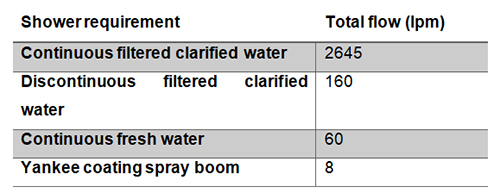
The above values have been obtained by using filtered clarified water (which typically has a suspended solid content of about 20 ppm) and enhancing its quality through cascade filtration steps to reach an average suspended solid content of about 10 ppm.
Among all tissue machine showers, some positions are more critical than others. Firstly, high pressure showers are fundamental to keep the machine cloths clean from contaminants, avoid open area reduction and guaranteeing proper water drainage during sheet formation. Secondly, chemical cleaning showers play a crucial role in preserving the good functioning of the wire and the felt during the paper making process.
Traditionally, both high pressure showers and chemical showers used fresh water. Thanks to the higher quality of filtered water, it is possible to feed high pressure showers with filtered clarified water, thereby reducing freshwater consumption.
In summary, the use of continuous fresh water is required by the following showers:
- Chemicals showers
- Suction roll seal lubrication shower
- Trim showers
- Tail cutter shower
In this configuration, Toscotec ensures a tissue machine water consumption lower than 2 m3/ton paper while guaranteeing optimal machine performances.
2.2 Suction roll sealing technologies
A traditional suction roll seal lubrication shower for a Toscotec AHEAD 2.2 tissue machine requires a freshwater flow of about 66 lpm to guarantee proper seal lubrication. Thanks to Voith’s new HydroSeal technology, this freshwater requirement has been reduced by approximately 87%. The required flow with HydroSeal is around 8 lpm.
HydroSeal is a seal strip with a lubrication system designed to drastically lower water consumption in suction rolls installed in the forming and press section. Along with its water savings, it also increases drive operation efficiency, thereby reducing energy costs [5].
Upon installation of the HydroSeal seal strips, the mill realizes the following benefits [5]:
- 78% reduction in water lubrication for seals, producing $17,500 and 11 million gallons of water in annual savings
- Improved seal strip lubrication performance for the mill’s tissue production
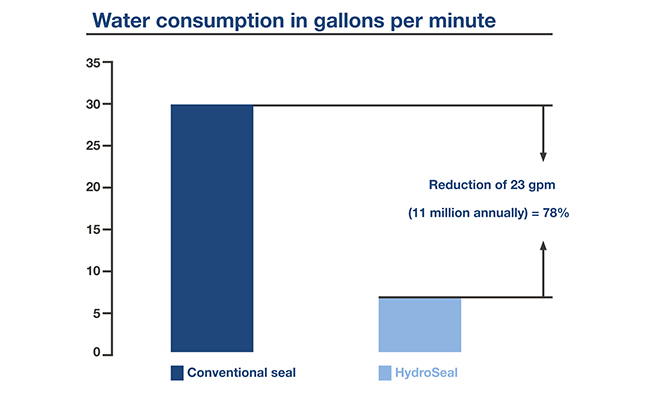 Fig. 2. Water consumption for suction roll sealing technologies
Fig. 2. Water consumption for suction roll sealing technologies
Additional benefits and advantages of Voith’s HydroSeal:
- Improvement of moisture profile due to uniform lubrication
- No unwanted remoistening
- Constant and even lubricant feed at each seal strip
- Higher operational safety of roll, fewer downtimes, lower maintenance costs
- Homogeneous lubrication over the complete width
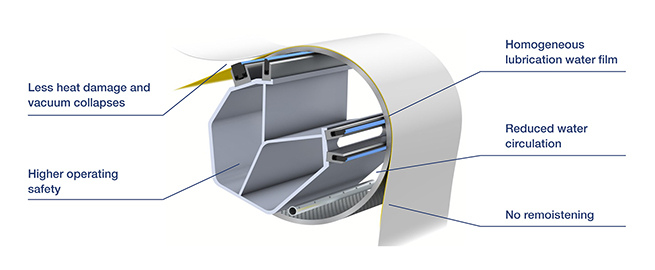 Fig.3 Voith’s HydroSeal configuration
Fig.3 Voith’s HydroSeal configuration
2.3 Cooling utilities management
The management of process water cooling can make the difference in water saving strategies.
In paper making plants, lubrication units, gearboxes and other utilities are usually cooled down by water. The management of this water stream plays an important role in the overall freshwater consumption. Generally, cooling water can be managed through an open or a closed loop:
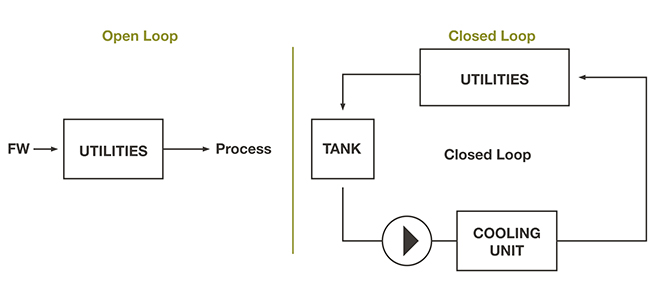 Fig. 4 Cooling water circuit configuration: Open vs Closed loop
Fig. 4 Cooling water circuit configuration: Open vs Closed loop
In open loop configuration, cold water is fed to the utilities and the resulting warm water can be used in the process for other purposes. In closed loop configuration, the warm water is cooled down through a dedicated cooling system and re-used to cool down the utilities again. Compared with the open loop, the close loop configuration reduces the amount of incoming fresh water through recirculation.
With the adoption of a closed loop management approach, it is possible to lower total water consumption to less than 4 m3/tons. This approach is usually more energy demanding than an open loop one, due to the cooling unit energy consumption.
There are several cooling units available on the market which have different operation concepts leading to different energy and water consumption figures.
In this study three kinds of cooling units have been evaluated:
- Cooling tower
- Adiabatic liquid cooler
- Chiller unit
The cooling tower has the highest water consumption of all the above, usually this type of machine requires a constant water flow make-up of about 10 to 15 lpm.
The adiabatic liquid cooler has the lowest energy consumption, but still requires a water flow of 1 to 5 lpm.
Chiller units have the highest energy consumption but do not need a constant make-up of water. With reference to the case study of Toscotec AHEAD 2.2 tissue machine plant with a maximum production capacity of 125 tpd, we must cool down a total water flow of about 400 lpm, which can be managed in a closed loop configuration that guarantees a cooling capacity of about 282 kW.
According to the above data, a close loop configuration based on cooling tower technologies requires 7205 m3 of water per year and an annual electricity consumption of about 52,440 kWh.
Whereas, if one selected an adiabatic liquid cooler, the annual water consumption would drop to 692 m3 and annual electricity consumption would also drop to 13,585 kWh.
A proper chiller unit would allow to save water and reduce the annual water consumption up zero, but it would require the highest annual energy consumption of all three option, equal to 307,979 kWh.
Besides the energy and water evaluation, it is also important to underline that mill location plays an important role in the selection of the cooling unit. When the wet bulb temperature is too high, the cooling tower and the adiabatic cooler become inefficient, and a proper chiller unit is needed to guarantee the necessary cooling capacity.
2.4 Stock preparation
The following water-demanding utilities can be found in the stock preparation system:
- Agitator and pump seal lubrication
- Hoses
- Chemical preparation units
Selecting the right sealing type can make the difference in the water consumption of the overall plant.
Each seal type has specific seal water flow and pressure requirements. Gland packing seal is the most common seal type used for pumps and agitators. Gland packing offers a lower upfront cost and easier installation compared to mechanical seals, as it does not require decoupling of drive shaft, resulting in a shorter turnaround time but lead to higher water consumption.
In general, glad packing seals require 5 to10 lpm which can increase if the sealing unit is not well regulated. In a typical Toscotec AHEAD 2.2 tissue machine plant with a max production capacity of 125 tpd where pumps and agitators are equipped with gland packing, the required water seal is about 100 lpm which accounts for 30% of the entire incoming freshwater flow. By installing mechanical seals on all pumps and agitators, it is possible to drastically reduce the total water seal flow (even though for certain equipment it is not possible to change seal type) reaching an overall stock preparation freshwater consumption of lower than 2 m3/ton of paper.
Another aspect worth mentioning is the amount of fresh water required for chemicals preparation and dosage. Chemical dosages and therefore fresh water required for chemicals strongly depend on water quality (conductivity, impurities content, cationic charge demand, suspended solid content, pH, temperature).
All the above-mentioned parameters are strictly connected with the plant’s water degree of closure.
Therefore, it is crucial to find the right balance between plant water closure (which mean freshwater reduction) and plant runnability.
The water requirement for the use of chemicals is not investigated in detail in this study, because there are several aspects that may come into play, including the sort of chemicals used, the type of production, raw materials, freshwater characteristics, etc3.
3. CONCLUSION
Water reduction approaches are very complex and lead to a progressive closure of the process water loop which gives rise to contaminant accumulation, and may cause paper defects, deterioration of product quality and machine run-ability issues.
The water consumption of today's papermaking processes varies between 5 and 20 m3/ton paper.
Toscotec has taken up this technological challenge and is actively contributing to the reduction of water consumption in tissue making through the development of new technologies and strategies which require less water consumption.
In this paper we summarized all the best practise and technological developments which allow to reach an overall plant freshwater consumption lower than 4 m3/ton paper.
The above figure can be reached acting on the different aspects of the tissue plant.
Thanks to machine showers optimization and Voith’s new HydroSeal technology, it is possible to obtain a total tissue machine water consumption lower than 2 m3/ton paper. To this result, we have to add the stock preparation water consumption that can be lowered down to 2 m3/ton paper through cooling utilities strategies and seal selection.
REFERENCES
[1] K. Olejnik, “Water consumption in paper industry – Reduction capabilities and consequences”, (2011) 113-129
[2] J. Boguniewicz-Zabłocka, I. Kłosok-Bazan “Sustainable Processing of Paper Industry Water and Wastewater: A Case Study on the Condition of Limited Freshwater Resources” 29 (2020) 2063-2070
[3] J. A. Neun “Paper machine water efficiency” (2021)
[4] M. Karthink, R. Dhodapkar, P. Manekar, P. Aswale, T. Nandy “Closing water loop in a paper mill section for water conservation and reuse” 281 (2011) 172-178
[5] https://voith.com/corp-en/VP_HydroSeal-Case-Study_19_1067_en.pdf
About Toscotec
Toscotec designs and manufactures machines, systems and components for the production of Tissue and Paper & Board, offering proprietary solutions to the world's leading paper industries: from complete tissue production lines to rebuilds, modernization projects and even single components. www.toscotec.com














